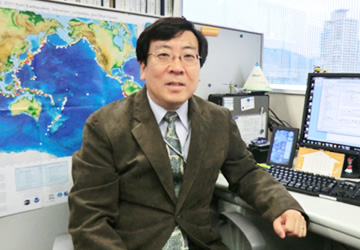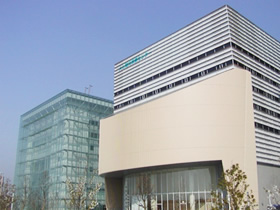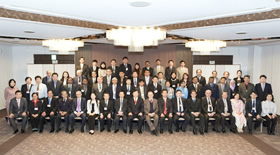Interview with Mr. Masami Sugiura, senior researcher, ADRC
The APRSAF Secretariat interviewed Mr. Masami Sugiura, a senior researcher of the Asian Disaster Reduction Center (ADRC), in March 2013. ADRC was established in July 1998; the Center has encouraged multinational cooperation for disaster reduction in the Asian region, and now it has 30 member countries. Mr. Sugiura discussed the significant role played by ADRC in Sentinel Asia, which starts STEP3 in 2014.
For further information on Sentinel Asia, including the explanations on STEP1-STEP3, please visit the following websites:
http://www.aprsaf.org/initiatives/sentinel_asia/
https://sentinel.tksc.jaxa.jp/
Secretariat: What is the role of ADRC in Sentinel Asia?

Through Sentinel Asia, ADRC connects 30 ADRC member agencies and Sentinel Asia member agencies to data providers, that is, space agencies. It receives Emergency Observation Requests (EOR) from member countries and forwards the EORs to space agencies after determining whether the EORs deserve actual observation.
S: Sentinel Asia is now moving from STEP2 to STEP3. How do you evaluate STEP2 and what does STEP3 focus on?

The ADRC office
(on the 5th floor of the right-hand side building)
The number of EORs and observations has been increased while implementing STEP2 (2008-2012), but we cannot simply compare the number of EORs because the number of disasters differs by year. However, we can say that this increase shows that Sentinel Asia has taken root in its member countries.
STEP3, based on STEP2, aims to cover all the phases of the disaster management cycle, which includes the overall flow from pre-disaster (mitigation/preparedness) to post-disaster (recovery).
This is very challenging and cannot be achieved immediately. For example, just after a disaster occurs, the degree of damage is obvious, but it cannot be clearly anticipated beforehand. Specifically, the glacier lake outburst, which led to a flood, detected too late. It is important to catch a sign by monitoring the situation before a disaster. This is quite rational and understandable but the selection of places to monitor from the many possible sites is difficult, because there are no clear criteria. On the other hand, some disasters require many decades to recover from, depending on the scale and/or type of the disaster. Also, there is the question of whether a voluntary base disaster monitoring initiative can deal with such a long-term effort.
Despite these difficulties, Sentinel Asia's participants have agreed upon the basic idea for STEP3. One of the objectives of STEP3 is to move forward, even if it is by one small step at a time. We all have to examine how we work to achieve concrete results.
S: Some APRSAF participants point out that Sentinel Asia is a success story among APRSAF activities and even other international projects, because Sentinel Asia runs smoothly and also puts up a good show.

The Asian Conference on Disaster Reduction 2013 in Japan
Almost every year since 2003, ADRC has organized ACDR, a conference where disaster management agencies and international organizations gather to promote comprehensive disaster management.
The key aspect of Sentinel Asia is that it comprises not only space agencies but also user agencies (disaster management agencies) and international organizations (such as UNOOSA, UNESCAP, and ASEAN), and they make up a team to form this voluntary base framework, which is one of the reasons for its success.
If a space agency or satellite data provider made products without considering inputs from other organizations and provided them to the user agency, the products would possibly be less useful. The user comes first and the provider later. I think the working structure between users and providers is important.
S: Finally, please tell us the future outlook of the ADRC and your expectations for APRSAF.
ADRC is the central point between each country's disaster management agency and space agencies in the flow of emergency observation. From this standpoint, we understand that the ADRC's role is to ensure smooth communication between the space agency and the disaster management agency. For that, we actively publish some related information through the ADRC Highlight as well as our website.
We expect APRSAF to retain its viewpoint of user base disaster management, and we are happy to support it in achieving its goals.
S: Thank you.